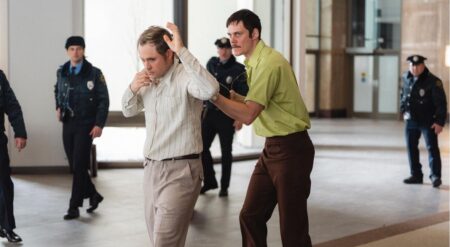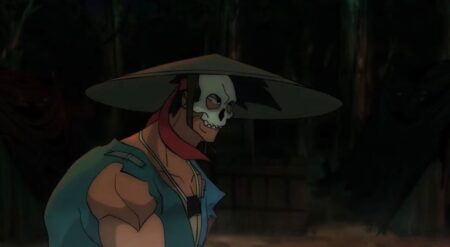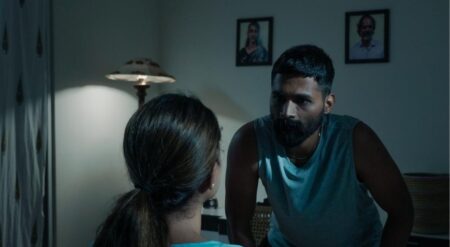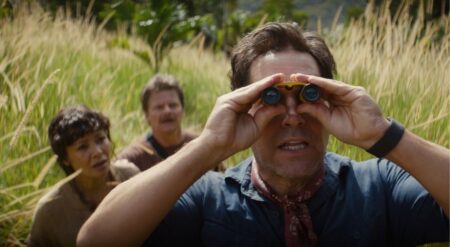There’s a scrappy, can-do energy to The Last Woman on Earth, the directorial debut from Yeum Moon-kyoung and Lee Jong-min that’s winsome. A committed belief that films can and will be made by those who, at the very least, have a camera and a story to tell. However, enthusiasm isn’t enough to make a good film. While this debut is certainly ambitious with some striking flavors, it stumbles in coming together as a fully formed picture with finesse.
The Last Woman on Earth, starring filmmakers Yeum and Lee, follows Hanah (Yeum), who is currently taking a liberal arts film class. Our first introduction to the character, with her shock of blue hair, comes through her pitch for the film. Set in 2099, all of the women on earth are extinct but one, who has now been locked away by men seeking to clone her. Hanah details her violent escape and revenge on her male captors as the movie plays a version of her vision, playfully shot to emulate the 4:3 aspect ratio of the silent era.
However, despite her fully realized story, her classmates aren’t invested in this blazing revenge story. Especially Cheol (Lee), who accuses her of misandry. Though Cheol’s perspective fails to garner respect. Not only can he not secure funding for his own film due to a lack of female perspective, but he is also a male film student type whose apartment walls are adorned with posters of Joker, A Clockwork Orange, and Taxi Driver. Sure, two of these films are classics. But take any film class ever, as a woman, and you’ll be able to spot these film bros.
Hanah rightfully critiques Cheol’s inability to write women characters.

The story in The Last Woman on Earth begins when the two strike up an unlikely partnership as they both seek to bring their films to life. Along the way, it tackles the insidious misogyny and cycles of abuse that permeate the film industry as the two try to find stable ground to tell their stories on.
A lot is going on in the film, and there are some bold ideas worth highlighting that the film executes with the necessary, scathing bite. Some of the best moments are when Hanah and Cheol work on their movies together, with Hanah constantly critiquing how Cheol writes female characters. Infatuated with Western media and big, Hollywood pictures, his first rewrite is to simply add a female character who is killed, as the protagonist wails about it in the rain.
“Never kill a woman for a man’s tear” is one of the best, most inciting lines of the entire film. Because how often have we seen women in media killed for the sake of the growth and grief of the male protagonist? It’s better avoided these days but not entirely inescapable.
Cheol continues to struggle to find a way to introduce women to his story and is constantly, rightfully torn down. From simply changing the gender of the lead characters to adding romance because he believes it’s the only way women characters can exist in an action flick, to basing his lead on the only woman he works closely with – Cheol – he clearly is lost about how to write women authentically. So much so that it’s hard not to A) want to see Hanah’s original, misandrist film in completion and B) wonder if Cheol deserves to make a film, period.
The Last Woman on Earth cycles through a multitude of styles and genres.

That’s where the tone sometimes loses itself. The Last Woman on Earth spends too much time with Cheol to make him the clear agitator. Instead, we’re meant to sympathize with both of them even though so much of Cheol’s storyline is “man learns sexism is bad.” Hanah, meanwhile, is a much more realized and interesting character whose story of revenge extends beyond her outline for her first film.
At one point, Cheol asks Hanah, “What kind of film will you watch when the world ends?” A line that speaks to the love of cinema. It’s the same as asking what kind of film would you show an alien who comes to Earth to explain what films are. There’s an apparent reverence for the medium that permeates every sequence of the film, making it lovable and scrappy in its B-movie rendering.
However, a lot is happening, and not every aspect is working. The film cycles through various styles, genres, and aspect ratios, incorporating musical interludes, animation, and documentary filmmaking techniques. And while it all speaks to the two characters’ love of the craft, it also creates inconsistencies. The best elements are in the DIY, indie filmmaking moments where the two simply try to figure things out. And it’s when those rougher edges and lower-budget details work. It speaks to the creative process and the hands-on approach.
Despite its flaws, Yeum Moon-kyoung and Lee Jong-min show promise as filmmakers.

However, the fervent, constantly changing stylistic approach results in a dizzying final product that is inconsistent. It’s not helped by the story struggling with pacing issues that is both about the creative process and the filmmaking underbelly, all while splitting the narrative into two perspectives.
The best version of The Last Woman on Earth is the one that sticks with Hanah and lets her anger propel the story along. Let her be aggressive and vengeful, forcing the audience to sit in that anger as she tries to create without the dissent of her original classmates and their dismal of her emotional storytelling.
The Last Woman on Earth is uneven but shows definite promise for filmmakers Yeum Moon-kyoung and Lee Jong-min. It’s one of those debut films where, despite its imperfections, you’re curious to see what they make next. With strong ideas and a stronger, singular voice, the film has vision – it just needed a finer edit and a more precise execution.
The Last Woman on Earth had its world premiere at the 2025 Fantasia International Film Festival.
The Last Woman on Earth
-
Rating - 6/106/10
TL;DR
The Last Woman on Earth is uneven but shows definite promise for filmmakers Yeum Moon-kyoung and Lee Jong-min. It’s one of those debut films where, despite its imperfections, you’re curious to see what they make next.







